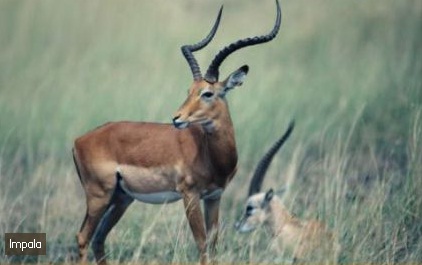Impala meat
- Customer pickup,
- Courier
- En details
(Afficher sur la carte)
The graceful impala (Aepyceros melampus) is a slender, medium-sized antelope so adaptable that it is found from southern Africa to the northern limits of East Africa.
Physical Characteristics
The body is reddish-brown with white hair inside the ears, over each eye and on the chin, upper throat, underparts and buttocks. A narrow black line runs along the middle of the lower back to the long tail, and a vertical black stripe appears on the back of each thigh. Unlike other antelopes, impalas have large, brushlike tufts of long, coarse black hair that cover a scent gland located just above the heel on each hind leg.
Habitat
Impalas are found at grassland and woodland edges, usually very close by water.
Behaviour
Their social organization allows impalas to adapt to prevailing environmental conditions. When food is plentiful, the males become territorial. In home ranges averaging 3 square miles, six to eight dominant males set up territories. They stand with erect posture, rub scent from face glands and make dung heaps to mark their territory.
The females form herds of 10 to 50 or more and wander in and out of male territories. If they start to leave the territory, the male tries to herd them back to the center, or he feigns danger just beyond his boundary by taking a stance normally used as a warning sign. He tries to mate with females in estrus and defends his territory from challenging males. Bachelor males are allowed to remain in male territories if they ignore the females.
The territorial male's challenger will have worked his way up through the hierarchy of the bachelor group until he becomes the dominant male. He then leaves the group and challenges a territorial male through horn duels, in which the males approach one another with slow, deliberate steps. At a signal, such as swiveling the eyeballs to show the whites or slightly nodding the head, they rush forward and clash horns, attempting to throw one another off balance. Although fighting can be fatal, males are protected by exceptionally thick skin over vulnerable areas. It is not the length of horn that gives a male the advantage but his condition and weight. When a territorial male begins to lose weight from his frantic activity, he is defeated and must return to the bachelor group to recuperate. There are times, however, when this territorial system is not maintained. In drier years the animals have to travel further to obtain food, and many smaller herds of females form. They move in and out of the territories so often that the males are very quickly exhausted. When this happens, territories are abandoned, and large, mixed tranquil herds of females and males form. When feed conditions improve, impalas revert to the territorial system.


